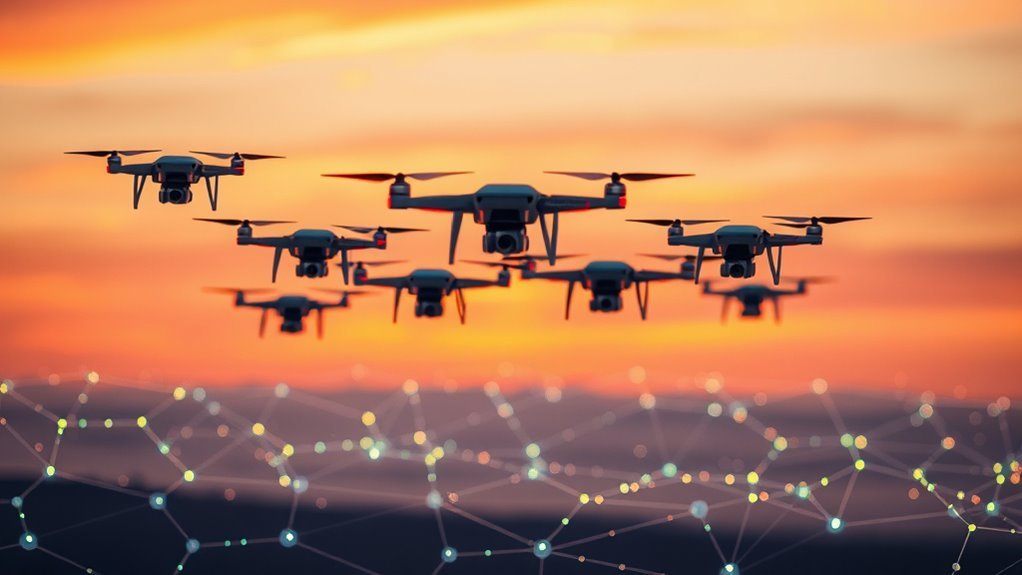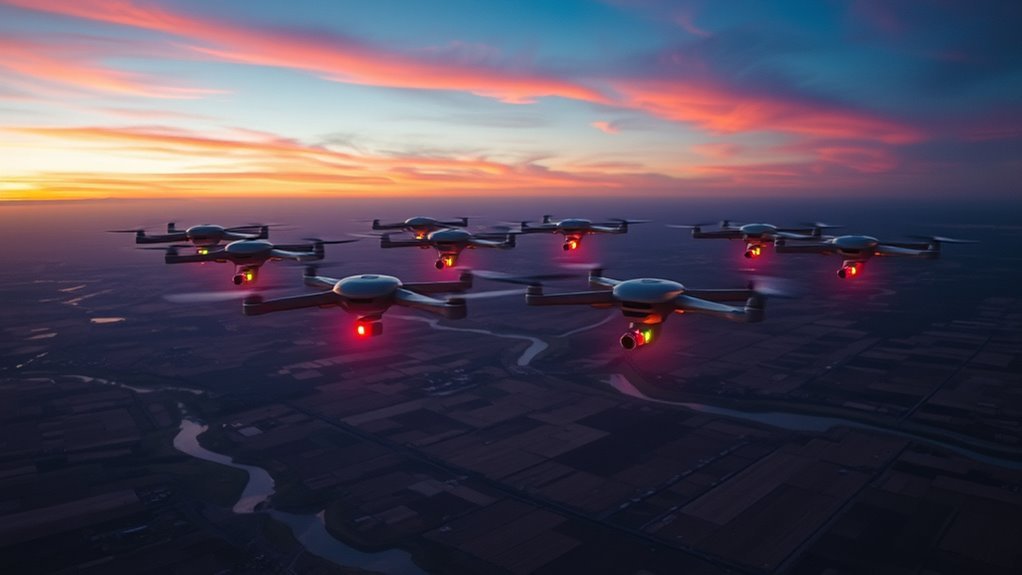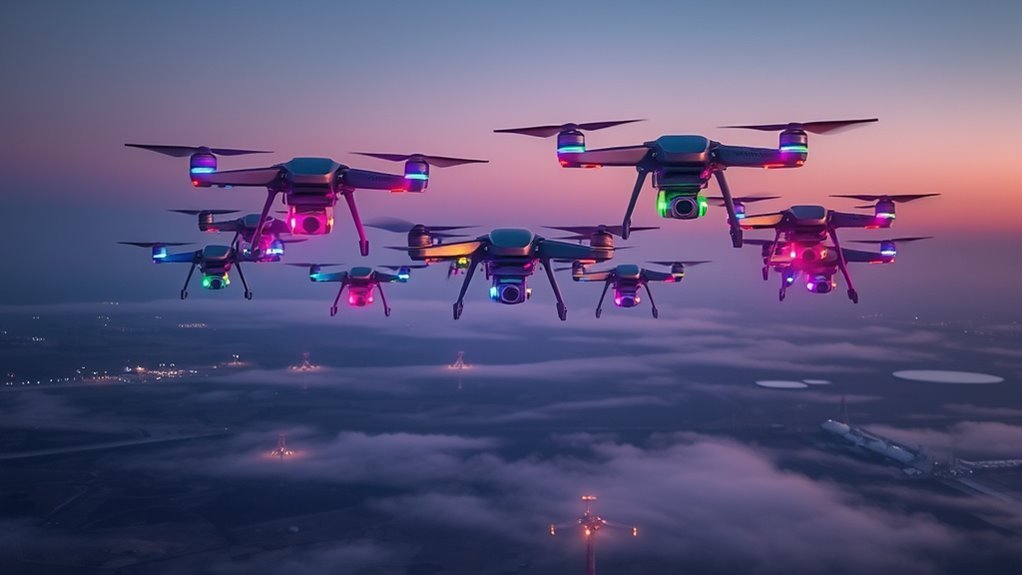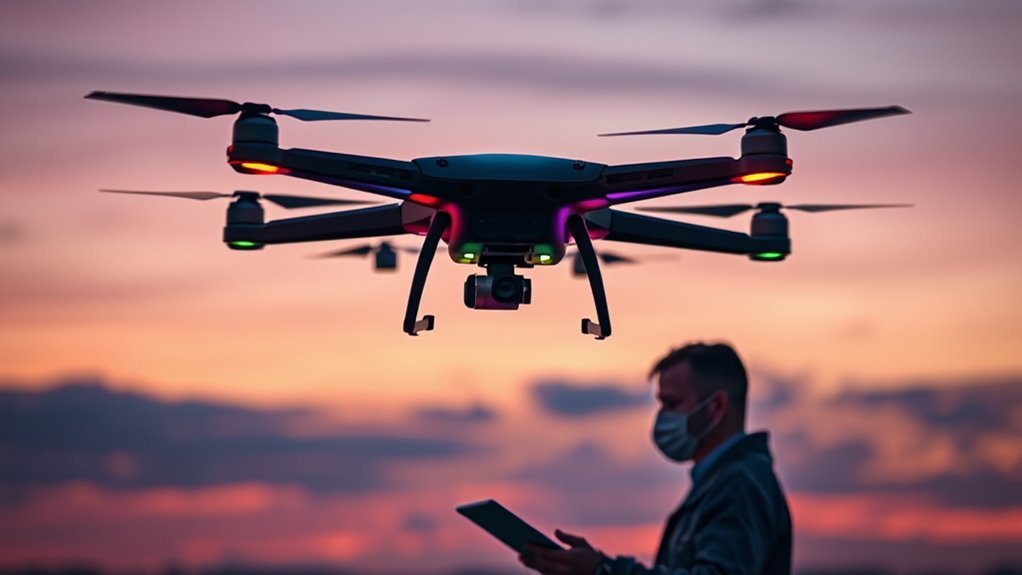Synchronized drones rely on advanced communication protocols, artificial intelligence, and sophisticated navigation systems. These technologies facilitate real-time data exchange and enhance decision-making through machine learning algorithms. Robust error correction and dynamic path adjustments guarantee reliable connectivity and adaptability in changing conditions. Integration of coordination algorithms promotes efficient teamwork among drones, while advanced sensors enhance collaborative capabilities. Exploring these technologies further reveals the transformative potential of synchronized drone operations in various applications.
Communication Protocols for Drone Coordination

As drones increasingly operate in coordinated formations, effective communication protocols become vital for seamless interaction. One promising solution lies in mesh networks, which enable multiple drones to communicate directly with one another, enhancing reliability and reducing the risk of single points of failure. By utilizing frequency hopping techniques, these networks can dynamically switch communication channels, minimizing interference and guaranteeing robust connectivity even in congested environments. This adaptability is essential for maintaining operational freedom, allowing drones to execute complex maneuvers without compromising their ability to relay critical information. By implementing these advanced communication protocols, you can guarantee that your drone fleet operates harmoniously, optimizing performance and expanding the potential applications of synchronized drone technologies in various fields. Furthermore, advanced distributed computing techniques ensure that large arrays of drones can be dynamically coordinated to prevent bottlenecks during performances. Additionally, the use of real-time coordination techniques allows drones to synchronize their movements with precision, enhancing the overall quality of aerial displays.
Role of Artificial Intelligence in Synchronized Drones

While many traditional drone operations rely on pre-programmed instructions, the integration of artificial intelligence (AI) transforms the capabilities of synchronized drones. AI employs machine learning and adaptive algorithms to enhance decision making, enabling real-time learning and behavioral modeling. This allows drones to autonomously coordinate their actions, optimizing task performance through predictive analytics and swarm intelligence. With cognitive computing, synchronized drones can analyze vast data sets, adapting to dynamic environments and changing conditions. This level of autonomy not only improves efficiency but also empowers operators with the freedom to focus on strategic oversight rather than manual control. Ultimately, AI’s role in synchronized drones is pivotal for achieving unprecedented operational capabilities and flexibility in various applications. Additionally, EHang’s advanced AI algorithms enable precise navigation and obstacle detection, further enhancing the synchronization of drone operations. Moreover, the collision avoidance systems used by both Amazon MK30 and EHang EH216-S demonstrate how AI can significantly reduce risks during complex flight scenarios.
Advanced Navigation Systems and Their Impact

Advanced navigation systems greatly enhance GPS precision, allowing synchronized drones to operate with remarkable accuracy. With real-time data sharing capabilities, these systems facilitate coordinated movements and decision-making among multiple units. As you explore these advancements, consider how they transform operational efficiency and safety in various applications. The integration of AI and IoT enables these drones to adapt swiftly to changing environments, further improving their effectiveness in the field. Moreover, real-time monitoring capabilities ensure that drones maintain stability and balance during complex maneuvers.
GPS Precision Improvements
GPS precision improvements have revolutionized navigation systems, enabling drones to operate with unprecedented accuracy. By enhancing the reliability of the GPS signal, these advancements lead to significant increases in positioning accuracy. This means drones can now pinpoint their locations within mere centimeters, allowing for intricate maneuvers and complex coordinated flights. The integration of differential GPS and advanced algorithms further refines this precision, minimizing errors caused by environmental factors. As a result, you can deploy synchronized drones for a variety of applications, from agricultural monitoring to search and rescue missions, without the fear of positional drift. Ultimately, these improvements empower users to explore the full potential of drone technology, granting them the freedom to achieve intricate tasks with confidence and precision.
Real-Time Data Sharing
As the demand for synchronized drone operations grows, real-time data sharing has emerged as an essential component of advanced navigation systems. This capability hinges on effective data synchronization techniques complemented by wireless communication advancements, enabling drones to operate cohesively in dynamic environments.
Key aspects include:
- Low-latency connections: Vital for immediate data transmission between drones.
- Dynamic data updates: Allowing for real-time adjustments to flight paths.
- Robust network protocols: Ensuring reliability in data exchange.
- Distributed computing: Enhancing processing capabilities across multiple drones.
- Interference mitigation: Addressing challenges in densely populated airspaces.
Embracing these technologies not only maximizes efficiency but also empowers operators to execute complex missions with greater autonomy and precision.
Real-Time Data Sharing and Processing
While the integration of synchronized drones offers numerous advantages, the ability to share and process data in real time is pivotal for their effectiveness. You’ll find that employing advanced data synchronization techniques guarantees seamless communication among drones, allowing them to operate cohesively. This is where collaborative processing methods come into play, enabling drones to analyze data collectively rather than individually. By distributing processing tasks, you can markedly enhance efficiency and reduce latency, which is critical for time-sensitive operations. Furthermore, leveraging edge computing can further optimize this process, guaranteeing that data is processed close to the source. Ultimately, these technologies empower you to maximize the potential of synchronized drones, paving the way for innovative applications across various sectors. Additionally, real-time coordination algorithms enable drones to adapt to changing environments seamlessly, enhancing their operational capabilities. Moreover, the integration of AI-driven approaches allows drones to autonomously anticipate obstacles and select ideal routes, further improving their efficiency and safety.
Swarm Robotics: Principles and Applications
In swarm robotics, effective communication protocols are essential for enabling drones to operate cohesively. You’ll explore various coordination algorithms and strategies that facilitate this interaction, optimizing task execution. Additionally, real-world applications illustrate the transformative potential of swarm robotics across multiple sectors. Furthermore, the implementation of real-time data analytics can enhance decision-making and coordination among drones in complex environments. Incorporating AI-driven alerts can further improve the responsiveness of drone swarms in unpredictable situations.
Communication Protocols in Swarms
Effective communication protocols are essential for the successful operation of drone swarms, enabling them to coordinate tasks, share information, and adapt to dynamic environments. These protocols facilitate seamless data exchange within mesh networks, enhancing the swarm’s efficiency and resilience.
Key elements of effective communication protocols include:
- Scalability: Ability to accommodate varying swarm sizes without losing performance.
- Robustness: Tolerance to interference and failure to maintain operational integrity.
- Latency: Minimizing delays in message transmission to enable real-time decisions.
- Security: Protecting data integrity and preventing unauthorized access.
- Adaptability: Adjusting dynamically to changing environmental conditions and task requirements.
Coordination Algorithms and Strategies
As drone swarms operate in complex environments, the implementation of coordination algorithms and strategies becomes crucial for achieving seamless teamwork. These algorithms facilitate multi-agent coordination, allowing drones to work collectively while adapting to dynamic circumstances. In distributed systems, each drone functions autonomously yet remains interconnected, sharing data and decisions to optimize performance. Techniques such as consensus algorithms, flocking behavior, and task allocation models guarantee drones can navigate, communicate, and execute missions effectively. By leveraging decentralized approaches, you can enhance resilience and flexibility in swarm operations. Ultimately, these coordination strategies empower drone swarms to accomplish intricate tasks, thereby expanding their utility across various applications while maintaining the autonomy that users value.
Real-World Applications Examples
Drones operating in coordinated swarms have found significant real-world applications across various fields, demonstrating their versatility and effectiveness. These applications not only enhance efficiency but also push the boundaries of what’s possible with autonomous systems. Here are some notable examples:
- Drone delivery of medical supplies to remote areas, improving healthcare access.
- Agricultural monitoring for crop health assessment, allowing for timely interventions.
- Search and rescue operations, where drones can cover large areas quickly.
- Environmental monitoring, tracking changes in ecosystems and wildlife populations.
- Infrastructure inspection, providing real-time data on structural integrity.
These applications showcase the transformative potential of synchronized drones, enabling innovative solutions to complex challenges.
GPS and Alternative Positioning Technologies
While GPS remains the dominant technology for positioning in aerial operations, various alternative positioning systems are gaining traction due to limitations in GPS reliability and accuracy, especially in urban canyons or densely forested areas. These alternative navigation methods, including visual-inertial odometry and radio frequency identification, address the challenges of GPS signal loss. By utilizing multiple data sources, they enhance positioning accuracy, ensuring drones maintain precise paths even in complex environments. Technologies like Wi-Fi triangulation and ultra-wideband systems can complement GPS, offering enhanced robustness. Asylon’s innovations in autonomous flights demonstrate how integrating these alternative systems can liberate your drone operations from GPS dependency, enabling more reliable performance across diverse operational landscapes. Furthermore, advancements in collision avoidance systems ensure that drones can navigate safely while utilizing these technologies.
Sensor Integration for Enhanced Collaboration
When multiple sensors are integrated into a drone’s operational framework, the potential for enhanced collaboration greatly increases. Sensor fusion enables drones to process data from various sources, allowing for a more thorough understanding of their environment. This collaborative sensing approach empowers multiple drones to work together seamlessly, sharing critical information in real-time.
Key benefits include:
- Improved situational awareness through diverse data inputs
- Enhanced obstacle detection and avoidance capabilities
- Greater accuracy in environmental mapping
- More efficient resource allocation in mission planning
- Increased reliability through redundancy in sensor data
Additionally, the use of advanced data encryption ensures that the shared information remains secure during transmission, further enhancing the effectiveness of synchronized drone operations. Furthermore, the integration of real-time data analysis features from AeroVironment’s software allows for swift, informed decision-making, which is crucial for maintaining operational efficiency.
Software Platforms for Multi-Drone Management
As sensor integration enhances collaboration among drones, the need for robust software platforms to manage these multi-drone operations becomes apparent. Effective multi-drone software provides intuitive management interfaces that enhance user experience while simplifying complex processes. Cloud integration allows for real-time data sharing and accessibility, facilitating mission planning and fleet optimization. Automation tools within these platforms streamline repetitive tasks, enabling you to focus on strategic objectives. Data analytics capabilities help you make informed decisions based on flight data and performance metrics, while adherence to interoperability standards guarantees seamless operation across different drone models. Additionally, thorough user training is essential to maximize the potential of these software solutions, empowering you to achieve operational goals efficiently and effectively. Moreover, real-time updates ensure that operators have access to the freshest data for informed decision-making, ultimately enhancing the effectiveness of multi-drone operations. The integration of advanced AI algorithms further optimizes flight paths and operational efficiency, allowing for rapid adjustments based on evolving mission dynamics.
Challenges in Synchronized Drone Operations
Although synchronized drone operations offer significant advantages, they also present a range of challenges that must be addressed to guarantee effective implementation. Maneuvering these obstacles is essential for achieving operational safety and compliance.
Synchronized drone operations promise benefits but face challenges that require careful navigation for safety and compliance.
- Regulatory hurdles: Adhering to local and national aviation regulations can be complex.
- Communication: Ensuring robust communication among drones is imperative to prevent collisions.
- Data management: Handling the large volumes of data generated poses significant technical challenges.
- Weather conditions: Environmental factors can impact performance and safety.
- Public perception: Gaining community trust and addressing privacy concerns is essential for acceptance.
Future Trends in Synchronized Drone Technology
As you explore the future of synchronized drone technology, you’ll encounter advanced communication protocols that enhance real-time data exchange among units. Incorporating AI and machine learning will enable drones to adapt to dynamic environments and optimize performance. Additionally, enhanced navigation systems will improve precision and safety in complex operations, driving innovation in this field.
Advanced Communication Protocols
While the landscape of drone technology continues to evolve, advanced communication protocols are emerging as a critical component for achieving synchronized operations. These protocols leverage advanced signaling techniques and facilitate multi-drone networking, guaranteeing seamless coordination among multiple units. Here’s what you should know:
- Real-time data exchange: Enables instant communication between drones for improved responsiveness.
- Robust error correction: Minimizes data loss during transmission, enhancing reliability.
- Adaptive bandwidth management: Optimizes communication channels based on operational needs.
- Secure communication channels: Protects against unauthorized access and potential interference.
- Interoperability standards: Guarantees compatibility across various drone systems, promoting flexibility.
AI and Machine Learning
With the rapid advancement of AI and machine learning technologies, the future of synchronized drone operations is set to transform dramatically. You’ll find that AI algorithms are increasingly capable of processing vast amounts of real-time data, enabling drones to make quick, informed decisions. This capability allows for improved coordination among multiple drones, enhancing their ability to execute complex tasks autonomously. Machine learning further enhances these systems by allowing drones to adapt to dynamic environments, learning from previous missions to optimize performance. As these technologies evolve, you’ll see a shift toward more intuitive and efficient drone operations, providing unprecedented levels of freedom and flexibility in various applications, from agriculture to disaster response. Embrace the potential of AI and machine learning for synchronized drone technology.
Enhanced Navigation Systems
Enhanced navigation systems are becoming pivotal for the future of synchronized drone technology, especially as they integrate advanced sensor technologies and real-time data processing capabilities. You’ll find that these systems markedly improve operational efficiency and safety.
- Enhanced mapping enables precise geolocation and obstacle detection.
- Autonomous routing allows drones to navigate complex environments independently.
- Real-time data sharing fosters collaboration among multiple drones.
- Dynamic path adjustments guarantee drones can adapt to changing conditions.
- Integration with AI algorithms enhances decision-making processes.
As these technologies evolve, you’ll experience a new level of freedom in drone operations, empowering you to explore possibilities that were previously unattainable. Enhanced navigation systems are setting the stage for unprecedented advancements in synchronized drone applications.
Frequently Asked Questions
How Do Synchronized Drones Ensure Safety During Operations?
To guarantee safety during operations, synchronized drones utilize advanced collision avoidance systems and adhere to strict safety protocols. This minimizes risks, allowing you to operate confidently, knowing the drones can navigate safely in complex environments.
What Industries Benefit Most From Synchronized Drone Technology?
Isn’t it amusing how synchronized drones revolutionize industries? They optimize agricultural monitoring, enhance search rescues, conduct environmental surveys, streamline construction inspections, elevate entertainment events, and improve delivery services—freedom through technology at its finest!
Can Synchronized Drones Operate in Extreme Weather Conditions?
Yes, synchronized drones can operate in extreme weather conditions, leveraging weather resilience and environmental adaptability. Their advanced technologies allow them to function effectively, ensuring you maintain operational capabilities regardless of challenging environmental factors impacting your missions.
How Are Synchronized Drones Powered and Recharged?
Synchronized drones, like birds in flight, rely on advanced battery technology for power. At charging stations, they rejuvenate, ensuring freedom to soar. Efficient energy management allows them to operate seamlessly, maximizing their potential in various environments.
What Regulatory Challenges Affect Synchronized Drone Deployment?
You’ll face regulatory compliance hurdles, as airspace restrictions often limit synchronized drone operations. Maneuvering through these challenges requires understanding local laws and potential changes, ensuring your deployments remain legal while maximizing operational freedom and efficiency.

